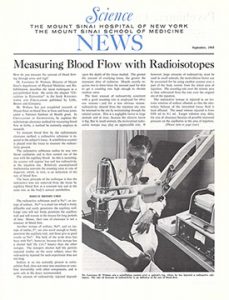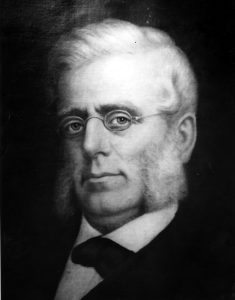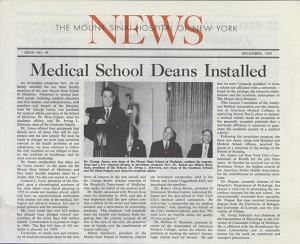Jun 11, 2020
This is a continuation of a guest blog post by Colleen Stapleton. Colleen is a Patient Navigator with the Liver Education and Action Program (LEAP) at Mount Sinai, where she works to improve linkage to care for patients living with Hepatitis C. You can read the original post here.
Scanning
My first day scanning, the team and I addressed the technology involved in making our Mount Sinai News collection available online. I learned about the scanning specifications to best archive our newsletters digitally. These specifications included 300 dpi (dots per inch), “do not scale,” and others particular to our scanner.
I also learned how to navigate the interesting physical space of the IT office, where the scanner was placed in a small kitchenette. Since I was scanning during lunchtime, I saw a few lunches popped in and out of the microwave. I learned that I could go ahead and put the precious paper newsletters on a non-descript plastic yellow barrel drum object, but under no circumstances should papers be placed on the potentially wet nearby water cooler!
Starting with November of 1958, I began electronically piecing together our carefully preserved collection of Mount Sinai Hospital history.
Folding Paper
Gently unfolding each 60-odd year old newsprint was both a physical challenge and delight. I soon fell into the rhythm of scanning the first page, then the second, then switching to scanning the inserted third and fourth pages. Since the newsletters are not stapled, in total I would carefully reverse the seams of two folded pages, then finish up with the back section of the first folded page.
After a few sessions, I noticed that the newsletters were getting considerably longer – some included 12 pages! This 12-page spread would include a total of three seams, and so unfolding and folding would come to resemble the act of taking apart and putting back together a precious Russian doll.
Troubleshooting
My first day at the scanner I became aware that any file containing more than five pages could not be sent via email to our Archives team account. I made the decision at this time to scan four pages at a time, sending the files to the Archives account in pieces. I soon saw the stacks of newsletters flowing from the “un-scanned” to the “scanned” pile.
After each session I would return to my desk and make sure every issue was represented and the scan quality was good. The various parts of each issue were then virtually ‘stitched’ together. Though some months came and went without Mount Sinai Hospital News editions, each newsletter is marked chronologically with issue numbers.

The first Science News insert of the new Mount Sinai School of Medicine
One of my favorite developments in my scanning came with the advent of the Mount Sinai School of Medicine Science News, an insert that was developed as the medical school was founded and produced more and more significant scientific discoveries. There was also the Mount Sinai Medical Center News title change in November-December 1969 to correspond with the newly built school of medicine. The history of Mount Sinai was expanding before my eyes and I had to ensure my metadata reflected these changes!
Moving Forward with Metadata
After scanning part I of the MSH News archive, the team met with the Aufses Archives’ Digital Archivist to clarify our strategy moving forward. We confirmed our goal of making the Adobe PDFs of the News pages available online, creating a digital index of all MSH News electronic files, as well as providing readers with a search function powered by Optical Character Recognition (OCR) to more easily search the newsletter files.
We identified questions to the tune of “How should we put the PDF files online?” and “how can we most easily create an index to the publication?” We ultimately decided to OCR the PDF documents with Adobe and then dump the words into a database program used by the Aufses Archives called DBTextworks. We started with a few pilot issue files and we identified any necessary metadata fields for our project.
So began an exciting new phase: cleaning and inputting metadata. Unfortunately, this was interrupted by the COVID-19 pandemic and the need to stay home, and we have not been able to continue the scanning. However, the work continues with the efforts of a fantastic new summer intern working remotely — soon all of the scanned issues will be described and searchable.
Stay tuned for more blog installments exploring this digitization project along with coverage of the many unique historical Sinai snapshots found in the MSH News!
Apr 24, 2018
As the spring very slowly arrives, the tired mind often screams for relief from the challenge of processing complex information. So, here is some Mount Sinai trivia that is guaranteed to interest without straining the brain.
Did you know:
…that in the 17th century there were Native Americans living in East Harlem and there was a stream flowing where the Icahn building now stands?
…that the first year The Mount Sinai Hospital was opened (1855-56), we admitted 216 patients, only five of whom were born in the US, and three of them listed their careers as comedians?

Mount Sinai founder, Benjamin Nathan
…that The Mount Sinai Hospital had a well regarded nursing school that existed from 1881-1971 and that 5 E. 98th Street was the School of Nursing dorm/educational building?
…that when the Hospital moved to its second site at Lexington Ave. and 66th St. in 1872, the Trustees built a large synagogue upstairs and a small operating room in the basement?
…that a Mount Sinai founder, Benjamin Nathan, was murdered in his sleep on a stormy night, and members of his family are still on the Board to this day?
…that Mount Sinai did not have an obstetrical service for the first century of its existence, only offering an OB Service when the Klingenstein Pavilion opened in late 1952?
…that there is a time capsule buried under the directory in the Annenberg Lobby that is scheduled to be opened in 2074, 100 years after it was placed there?
…that Jonas Salk and Henry Heimlich both served their internships at Mount Sinai, Salk graduating in 1942 and Heimlich in 1948?
…that in 1964, Mount Sinai had 1,326 beds, 200 more than we have today?
…that when the first ICU opened at Mount Sinai in 1962, it had five beds and was located in 1184 Fifth Ave., on the 7th floor?
…that in 1993 Mount Sinai School of Medicine became the first in New York State to graduate a class with more women than men?
…that there are at least 43 diseases, syndromes, tests, instruments and phenomena named after Mount Sinai physicians and scientists?
Nov 4, 2015
Fifty years ago, on November 30, 1965, the first Deans of the new Mount Sinai School of Medicine were installed. These men were: George James, MD, MPH, Dean of the School of Medicine, as well as the founding chairman of the Department of Community Medicine (today’s Preventive Medicine department); Irving Schwartz, MD, Dean of the Graduate School of Biological Sciences and Chairman of the Department of Physiology; and Hans Popper, MD, PhD, Dean for Academic Affairs, Chairman of Pathology, and a pioneer hepatologist. At the investiture ceremony held to mark the occasion, many statements and promises were made about the future of the new school. With hindsi ght, we can see that many of these not only came true, but remain relevant today.
ght, we can see that many of these not only came true, but remain relevant today.
Gustave L. Levy, Chairman of the Board of Trustees at Mount Sinai, noted that it was important that the school would have courses not only in the biomedical sciences, but also in the social sciences and humanities. This emphasis on the value of the humanities has had an up and down history at Mount Sinai, but it was revived again in 1987 with the creation of the Humanities in Medicine program and today’s expanded FlexMed admission program, as well as the 2012 creation of the Academy for Medicine & the Humanities. George Baehr, MD also spoke at the event about the value of the social sciences. He graduated from Mount Sinai’s house staff in 1908 and led the First Medical Service at Mount Sinai for many years. Baehr led Mount Sinai’s World War I unit and later created HIP for his friend and patient, Mayor LaGuardia. Dr. Baehr said in his remarks that it was important that medical students be exposed to the humanities and community medicine, because it will “hopefully keep our faculty and students from forgetting that the primary purpose of all this is the care of the sick, the preservation of health, and the amelioration of human suffering.”
Finally, Dr. James outlined standards that have guided Mount Sinai over the last 50 years. He said Mount Sinai has “four separate responsibilities”: “We must constantly be humble, we must constantly welcome criticism, be critical of ourselves, and be ready to change. The second responsibility we have is that of relevance… We must always remain part of the community. We must always be alert to the solution of the problems which are current in the community, and in the world… It is essential that this institution remain relevant to the health problems of our era, no matter what they be – and they will change – and no matter what problems are brought to us in the years to come. The third responsibility we have… is the responsibility for excellence. We are not privileged to follow in the footsteps of those who went before if we will not accept this challenge for excellence. There must be no compromise with it, no compromise under any circumstances. One final responsibility that we must assume… is the responsibility of leadership. … The institution has prided itself by being always among the forefront of medical care and research institutions, and those of us associated with it must be prepared to at least try to carry it to new heights.“
For more on the Archives or the history of Mount Sinai, contact us at msarchives@mssm.edu




